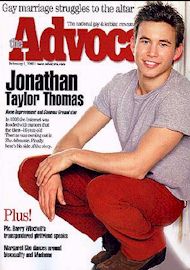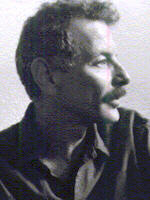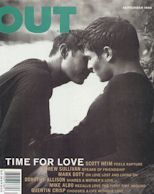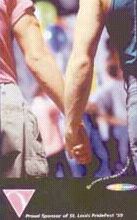 |


|
|
and Real Gay Culture
But at that time, despite the fact that the gay press was pretty much a home-grown industry and virtually everyone in it knew everyone else, there was an excitement and a touching closeness to the actual gay community, especially the gay arts community, that has gone. It's disappeared in the smoke and mirrors of American Express, Tanqueray Gin, Phillip Morris, and Benneton ads. One thing is clearly true: as the national gay print media has become more mainstreamed and professionalized so that you can actually make of a living out of it it has also moved further and further away from the people who are actually making "gay culture."
I'm also talking about gay and lesbian painters and photographers who are not Soho celebrities, but who're making important images. And about openly gay, serious (i.e. non-"celeb) singers, musicians, choreographers, dancers, composers, designers in short, anyone who is actually making living, breathing "gay" culture, that thing that the mainstream corporatized media has been trying to declare "dead" now for about a decade. One result of "gay culture"'s death, as the mainstream press (both gay and straight) sees it, is that it no longer has box office "legs" that are Michael-Jordan strong enough to make Simon and Schuster (and other mega-media conglomerates) salivate at the cash registers. So many more of our books are coming out of smaller independent presses, presses with tiny, tiny budgets for advertising and publicity. So the wisdome is: the queers have not only hit the money glass ceiling, it knocked us flat. There just ain't as much gold in our "limitless discretionary" coffers to make us worthwhile. We're over. Dead. I hear this constantly: that "gay culture" itself is at a deadend. It's a non-issue. A no-brainer. In fact, there are no brains in it. It died with disco (yeah, sure!). The "issues" that are "gay issues" no longer even appeal to younger queers. Their issues are money, family, relationships, real estate, fashion all things that the mainstream "gay magazines" try to approach from an angle that is as "least gay" possible. (The strange converse of this is that I hear younger people complaining to me that there is nothing in the national gay press that does not distinguish it from Conde Nast.)
An example of this (although the magazine has denied this constantly) is that for a long time, OUT magazine refused to review actual gay books unless they came with an ad budget for OUT. When James Collard was editor, he declared that he was more interested in things gays should be interested in as "gay consumers"than in anything that would mean something either to gay culture or writing. (On their side, OUT will tell you that they have reviewed or mentioned some independent or university press books: however, as the saying goes, "One swallow does not make a summer" or a meal.) As a "gay-media whatever," I was given a free subscription to OUT for several months. I followed the books reviewed in the magazine. I was appalled. They were virtually all what are called in the trade "window dressing books," the kind you might keep on your coffee table when your Republican parents from Oshkosh came to visit. Most of them were celeb books or design books, with a few major press "lit'rary" books thrown in. None of these books might not have been reviewed in any other national magazine. Some were reviewed in People. So the idea of going to a national magazine to learn about books that really appeal to your own life anyway, OUT has made this into a fairly foreign idea.
When I do pick up OUT now, I am bored to hell: the ads are the same ads you'd find in any other slick magazine; the articles are the same articles, with a few exceptions thrown in. It makes The New Yorker look "gay." Closer to home, that is, the fact that it's been with us longer, The Advocate has become (to the book trade) virtually "bald" they make little effort to cover up the fact that they will neither give review space nor editorial mention to books that do not advertise with them. Even better, they give most attention to their own books, books published by Alyson Press, now owned by The Advocate. When one of my books from Belhue Press was on their bestseller list, I wrote to Judy Weider, The Advocate's editor, that this book had been given no review coverage or editorial mention in her magazine as none of my books ever have, even though I have been a finalist for national Lambda Book Awards four times and my books have been reviewed well in London's Gay Times, the magazine that is the closest the English have to The Advocate. My letter was not answered. I have spoken to other writers who've told me the same thing: don't expect much or anything in black-and-white, unless you flash the green with them. I have been told, over and over again, by writers who deal with The Advocate (or, for that matter with most of the slick national gay press) that only when "gay interests" intersect with the mainstream (a.k.a., our dollar culture) are they interested. They feel that this is what their readers are most interested in, when in fact, that is not true. Huge numbers of gay and lesbian readers still like the idea that they might discover something in their own press that they will not find in Details. (Actually, for that matter, Details is sometimes "gayer" than OUT. Both magazines often share the same ads, verbatim, and even the same tone.) So "gay culture" now appears to be dead. It has a constant shallow, brittle, consumerist knife buried in it. It is so boring that it actually becomes tiring. And this is what we read about in the national gay press.
In short, I recognize that there are thousands of gifted, openly gay artists, writers, dancers, playwrights, singers, composers, choreographers, designers a complete movement of living culture, who are never mentioned in the national gay press, unless, somehow they become mainstreamed enough to get some ad revenue or P.R. machinery behind them. This has made real gay culture to me as exciting, as vital and evolving, as the Jewish and Southern cultures that I came from. While their pictures will never appear on the covers of OUT and The Advocate (or, for that matter, inside them as well), at least not in the current form that both magazines are taking, these individuals are what my own feeling for gay culture is about. I see that the national gay press always misses the boat with these makers of a real culture. But even worse, it gives a lot of our community and the world the impression that the boat never left. Perry Brass's 11th book, Angel Lust, will be in the bookstores this March. His books are available at gay community bookstores nationally as well as online. He can be reached at belhuepress@earthlink.net. |
 © 1997-2000 BEI
© 1997-2000 BEI
 The national gay magazines, even The Advocate, have turned away from gay activism and toward pop culture
The national gay magazines, even The Advocate, have turned away from gay activism and toward pop culture  Author Perry Brass
Author Perry Brass Later, after my free sub ran out, I was offered a dollar-an-issue
subscription; I figured at worst it would be worth that. By this time, I
was so sick of the magazine's attempt to turn itself into a brittle Brit
"shelter rag," modeled after Wallpaper (via James Collard) that I let
even that drop. Several of my writer friends told me that they got more
out of reading the J. Crew catalogue.
Later, after my free sub ran out, I was offered a dollar-an-issue
subscription; I figured at worst it would be worth that. By this time, I
was so sick of the magazine's attempt to turn itself into a brittle Brit
"shelter rag," modeled after Wallpaper (via James Collard) that I let
even that drop. Several of my writer friends told me that they got more
out of reading the J. Crew catalogue.
 Advertisers like Budweiser are designing ads specifically for the gay audience
Advertisers like Budweiser are designing ads specifically for the gay audience